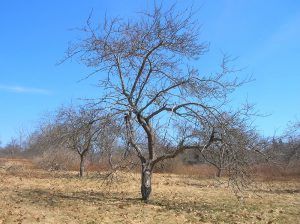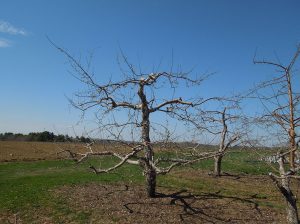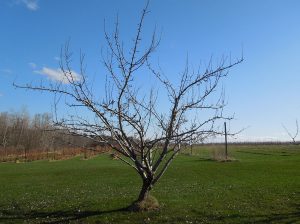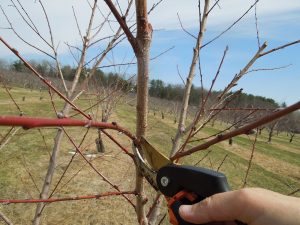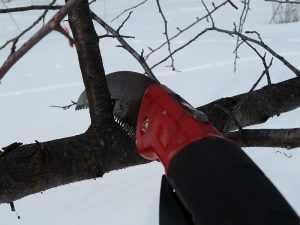Pruning

Pruning corrects the natural tendencies of fruit trees that may be counterproductive to growing fruit or undesirable. The natural tendency to grow too many shoots and large branches ultimately causes shading in the interior canopy and lower branches. This lack of sunlight inhibits flowering and weakens branches. Trees with an open, well-lit canopy grow larger fruit compared to trees that grow into a thicket. Because they are trees, they can grow to tall heights, which creates difficulty in harvesting. Branches that grow beyond a height or length that is desired can be shortened or removed by pruning. Trees can be pruned to have a certain shape that is designed to be more fruitful or to be visually pleasing within the landscape. Pruning is the standard way to remove dead and dying branches. The tendency of apple trees to bear fruit in alternate years can be partly corrected with pruning. There are many reasons for pruning fruit trees.
The best time to prune fruit trees is late winter into early spring when it will least affect winter hardiness and tree health. Summer pruning in late July or August is another time when pruning can be performed, but severe pruning at this time will weaken the tree. Therefore, the majority of pruning should be done during winter or spring. Pruning lessens winter hardiness to a small degree, so pruning in early winter can lead to winter injury when it is followed by severely cold temperatures. It takes two weeks for the tree to regain winter hardiness that is lost due to pruning.
The same tree can be pruned in many different ways. How to prune fruit trees depends on expectations and individual reasons for growing fruit trees, preferences for tree size, shape and willingness to expend time in performing the task. One person may want fruit trees that have a natural, unpruned appearance, but may want to correct an overgrown canopy to increase sunlight for healthier branches. Another person may wish for a more manageable tree size or a tree that bears large, well-colored fruit. A tree pruned so that it keeps its natural appearance will be pruned differently than a tree that is cultivated primarily for fruit growing.
Shapes of Fruit Trees
Fruit trees can be pruned to have a natural shape or pruned to have a more cultivated look depending on the degree of pruning and types of pruning cuts made. Allowing the tree to grow naturally without any shaping is preferred by those who do not favor the more cultivated styles of pruning. This method may result in a very tall tree, but is the simplest to accomplish and is appropriate for fruit trees that also function as flowering ornamentals. A different option is a single leader tree with one dominant vertical trunk and several side limbs that grow upward with numerous fruiting branches. The single leader shape is suitable for dwarf trees which are naturally short. When the tree is narrow at the top and wide at the base, as is the case with most single leader trees, more sunlight reaches the lower branches. A third option, the multiple leader system, involves two or more dominant branches that grow upward and angle out away from the tree center. This shape helps to maintain a shorter tree and is useful for trees that can grow very tall such as plums and peaches. The best option depends on the size of the tree when it is fully grown and on personal preference.
Espaliered trees are thin canopy trees pruned to grow along a wall or trellis. They can be trained as multiple leader or single leader. They are not considered natural since fruit trees do not grow in a flat plane in nature. To accomplish an espalier with minimal hassle, plant dwarf trees.
- Natural or unpruned trees have dense canopies that lack sunlight.
- The single leader tree had several side limbs oriented horizontally to capture sunlight. Annual pruning removes some of the branches that shade the rest of the tree.
- The multiple leader tree has several limbs that grow upward and outward at an angle which helps to keep the tree short.
Types of Pruning Cuts
Removal of shoots or branches is accomplished with either the thinning cut or the heading cut. The thinning cut is the complete removal of the shoot or branch at its base where it joins the rest of the limb. This type of cut has minimal impact on the appearance of the tree. It is useful for removing dead branches or when the tree has an excessive number of limbs or branches. In contrast, the heading cut is removal of part of the shoot or branch so that part of it remains on the tree. Heading cuts are useful for shortening branches. The heading cut changes the direction in which the shoot or branch is growing and consequently alters the tree appearance. It also invigorates the buds and shoots that are closest to the cut. In general, thinning cuts reduce the number of branches on a tree and heading cuts increase the number.
- A thinning cut removes the branch at its junction with the trunk or limb.
- A heading cut removes part of the branch and should be made at a point just above a side branch.
Both thinning and heading cuts can be made on large branches or small shoots. When pruning into a large branch, the cut can be made in the older section where side branches are already developed. When pruning into a new shoot, an increase in the number of lateral branches will be the result. Avoid heading cuts into new shoots in order to encourage the formation of flower buds instead of new shoots.
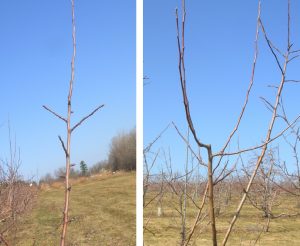
How To Prune Apple Trees Video
Tree Vigor

Pruning practices can be adjusted to maintain the balance between shoot growth and fruiting and to prevent an overstimulation of the shoots. In order to accomplish this, an understanding of shoot vigor is needed. Vigor is simply the amount of shoot growth that occurs in one year. At the base of the shoot, a ring or small ridge occurs that completely encircles the shoot and indicates the beginning of this year’s shoot and the end of last year’s. The length from basal ridge to the shoot tip is the length of shoot growth that was made in the current year.
Shoots that grow two or more feet in one year are considered vigorous and unlikely to bear flower buds in the coming year. Shoots that grow less than four inches are called spurs. They cease growing earlier in the summer, and begin to form buds which usually bear flowers and fruit in the following year. For a good balance between shoots and fruit, a fruit tree should have a mix of spurs and shoots that are one or two feet in length. When a tree grows mostly strong shoots, it is vigorous and should be pruned lightly to prevent additional stimulation of strong shoots. Trees that lack strong shoots and have a predominance of spurs are lacking vigor and will not likely be invigorated by severe pruning.
When a tree is vigorous, it forms fewer flower buds than trees that are lower in vigor. As a rule, vigorous trees should be pruned with this in mind to prevent the removal of too many flower buds. When a tree is weak, it may have too many flower buds, some of which can be removed with detailed pruning to help restore the balance between fruiting and shoot growth.
Flowering and Flower Buds
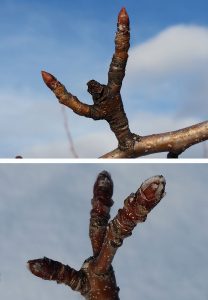
Fruit trees form flower buds in the season prior to their bloom, usually in summer. They continue to develop through the fall and winter. In spring, the flower bud blooms, bears fruit and grows another shoot or spur that repeats the same process.
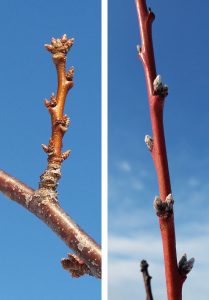
In apple and pear trees, flower buds occur at the tips of short shoots and spurs. They are swollen at the base and have a more rounded shape and larger size than buds that have no flowers. As a shoot grows, it increases in length and eventually forms a bud at its tip. Shoots that form a terminal bud in late spring or early summer have more time during the rest of the season to form into a flower bud. Shoots that continue to grow into late summer or fall are less likely to have a flower bud form at the tip, so it remains a leaf bud instead. Along the length of the shoot, buds also develop, but these rarely become flower buds. The following season, the lateral leaf buds will grow into short shoots, called spurs, that typically end in a flower bud. This is how branches grow if left unpruned. Pruning with heading cuts disrupts this process by stimulating buds to grow into strong, leafy shoots rather than spurs with flower buds. For this reason, avoid heading cuts in new shoots.
In peach, plum, cherry, and apricot, shoots grow in a similar manner, but flower buds are formed along the length of short shoots and spurs rather than at the tip of the shoot. The shoots and spurs consequently have a mix of both leaf and flower buds along their length. The shoot tip always forms a leaf bud in the stone fruit trees.
Pruning Decisions
Pruning involves a number of decisions about which branches to remove. Eliminating the excess is the essence of pruning, and deciding what is excessive is the first step. To begin, examine the tree from all angles to observe the size and shape of the tree, to find crowded spots with too many branches, and to find dead branches. Once the problems have been identified, decisions about what to prune can be made. It may be helpful to work from the opposite perspective and ask yourself what should not be removed. In this case, you would prune the rest of the tree in a way that favors these branches that have been selected.
Dead branches are not essential to the tree and can be eliminated without further thought. They are typically removed with thinning cuts when the entire branch has died. If only the tip is dead, it can be removed with a heading cut by pruning at a point just above a side branch when it is not desired to remove the entire branch.
Examine the size and shape of the tree and decide if it is too tall, too wide or growing too closely to the ground. Identify which branches are too tall or too long and remove them with thinning cuts or shorten them with heading cuts. In some cases, this may entail a large portion of the tree. Decide how much should be removed this year and leave the rest for the following year to avoid over pruning. If the tree has not been pruned recently, there will likely be a decision regarding which of several limbs should be removed. Look closely at each and select limbs that have fewer flower buds or are generally unproductive. Where two limbs or branches are occupying the same space, one should be removed.
Examine how densely the tree grows. Does each limb have sufficient space for its side branches and is there sufficient light reaching the inside and lower branches. If not, then look for limbs or branches that are too close to others and blocking sunlight. Some or all of these can be eliminated with thinning cuts. Deciding how many to remove in one season depends on tree vigor or how long most of the branches have grown. For very vigorous trees, remove one or two large branches at a time and leave others until next year. This will lessen the rebounding effect that pruning has on tree vigor. For trees that are less vigorous, more branches and limbs can be removed without the subsequent invigoration of the tree. If you are not bothered by the consequences of severe pruning, remove as much as you like in one year.
Examine the branches closely to see if they have grown flower buds in abundance or sparsely. This may require several years of experience and comparison from year to year since the classification of “too many” or “not enough” is an individual decision based on preference for how many flowers and fruit should be borne by the tree. With experience, pruning decisions of which branches to eliminate will be guided by how many flowers buds they bear.
One of the guidelines for selecting branches is the angle at which they grow. Branches that point down are weak and usually unfruitful. Watersprouts, branches that point directly upward are usually too vigorous and overshadow other branches. In either case, remove these types of branches and keep ones that point at an angle instead of straight up or down. If the tree has only watersprouts, keep the weaker ones since they eventually bear fruit.
Pruning Tools
A number of pruning tools can be used to make pruning easier. However, some trees are too large to be safely pruned with common tools. For very tall trees, it is best to hire a professional to prune the tree back to a manageable size before attempting to prune it yourself. For trees that have grown into power lines, contact the power company to correct the problem before attempting to prune in this dangerous situation. During pruning, protect your eyes from injury by branches. Safety glasses are strongly recommended to prevent branches from poking your eyes.
For removing limbs and large branches, hand saws, and pole saws are the preferred tools. Avoid climbing trees or standing on old branches since they have poor structural strength and will likely break. Instead, use a pole saw or a tripod ladder to reach the tallest branches.
Loppers with a bypass blade are useful for removing small limbs and branches. They can reach into tight spaces more easily than some saws.
For detailed pruning and removing small branches, bypass hand pruners are recommended over anvil pruners since they can make a flat cut. Anvil pruners leave behind a small stump that will grow new watersprouts.
It is not necessary to seal pruning cuts since the wood naturally seals itself to prevent desiccation and fungal invasion.
Renovating a Neglected Fruit Tree
When fruit trees have not been pruned in many years, they can become overgrown with too many branches and have the tendency to bear only small fruit. Lower branches may die from lack of sunlight. However, the amount of pruning needed to correct this may be substantial and should be done over a period of three to four years to avoid the consequences of over pruning.
Begin by removing all dead limbs and branches. If most of the lower limbs are dead, the resulting shape of the tree will be altered after pruning.
If pruning will involve the removal of large limbs, this should be done first before detailed pruning. Where two limbs are growing too close to each other, remove one with a thinning cut. This may require the use of a saw and may entail the removal of a large branch. In many cases, the tree is too tall for safe fruit picking. Removing the tallest branches will shorten the tree and allow more sunlight to reach the lower branches. Remove large limbs in sections or with the help of another person. Avoid over pruning by removing only one or two large limbs each year. In the following year, some of these pruned limbs may regrow new shoots from the edge of the cut. One or more can be kept to replace branches that have died.
Finish the pruning by removing smaller branches and spurs as needed so that the remaining ones are not crowded. For balance and sunlight, remove more branches in the top of the tree. As a general guideline, remove 75% of the branches in the top and 50% in the lower part of the tree.
In the next year, continue to remove large branches that crowd others. At some point, there will be no more limbs that crowd others. In this case, prune to maintain the shape of the tree and to thin out branches to keep the tree from becoming crowded.
Maintenance Pruning

The main purpose of maintenance pruning is to prevent branches from crowding each other, and to keep the tree a certain size. It is best to begin with the largest pruning cuts that need to be made, such as the removal of any limbs that grow to close to other limbs. Follow this with detailed pruning such as shortening branches and removing branches where there are too many. The same steps that occur with pruning neglected trees can be followed, but remove fewer limbs and branches.
Pruning Newly Planted Trees
Fruit trees can be pruned at planting to develop the shape of the tree. After this initial pruning, they should be pruned as little as possible until they begin to bear fruit every year, generally from five to seven years after planting. Pruning encourages the growth of leafy shoots rather than flower-bearing shoots, so trees remain in an unfruitful state for a longer period of time.
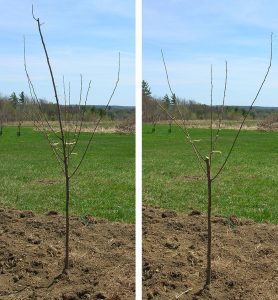
To establish a single leader tree, leave the main branch unpruned. Remove any side branches that are too low to the ground and any that are broken or dead. To establish a multiple leader or vase-shaped tree, prune off the top of the tree at a point above four or five side branches or at a point about 30 to 36 inches above the soil. The point where this cut is made will determine the height of the lowest branches on the tree, and can be adjusted to a higher or lower point. For a vase-shaped tree, the new shoots should be encouraged to grow outward to form the main branches. Pears and sweet cherries tend to grow vertically, so it may not be easily done in these two species.
To maintain the vase-shaped tree, branches should not be growing completely upright nor should they be horizontal, but somewhere in between these angles.

Trees can be trained to many different shapes. The best time to do this is in the formative years, starting in the first year after planting. Once the framework of the tree is established, it is difficult to reshape it. Pruning nonbearing trees should be kept to a minimum until the tree reaches maturity or full production, generally at an age of six to ten years. Severely pruning a young tree will keep it in an unfruitful state for a few additional years.

